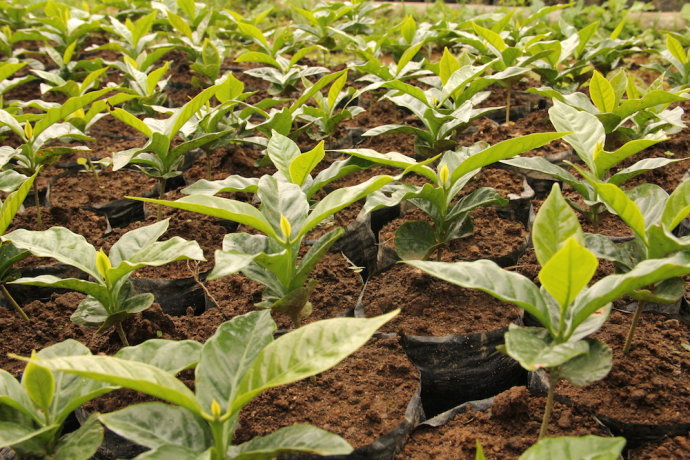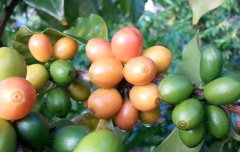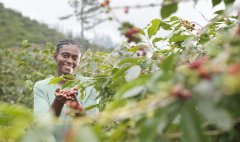Conditions for growing coffee beans grow coffee at home
For professional baristas, please follow the coffee workshop (Wechat official account cafe_style)
Coffee is generally suitable for growing in places where the climate is warm, sunny and Rain Water is moderate (alternating wet and dry climate). The circular zone centered around the equator and between the north and south latitudes of 25 degrees is the natural growth area of coffee, which is usually called the coffee belt. 1. Humid, warm tropical and subtropical climate with no frost all the year round. Arabica coffee is not resistant to high temperature and humid climate and can not stay at a low temperature below 5 °C for a long time, so it is mostly planted on steep slopes at an altitude of 6-2000 meters above sea level. On the other hand, Robusta coffee is planted in lowlands 200-600 meters above sea level because of its strong adaptability. The average rainfall throughout the year is 1500-2000 mm. At the same time, the rainfall time should be in line with the flowering cycle of coffee trees. Flowering and young fruit stage are the most suitable for growth and development. 2. The annual average temperature is between 15 and 25 degrees Celsius, which must not be lower than 12 degrees Celsius. If the temperature is lower than 20 °C, it cannot grow normally. 15-24 ℃ is the ideal temperature for Arabica coffee, while Robusta is 24-30 ℃. There are more than 60 coffee producing countries in the world, most of which are located between the Tropic of Cancer (latitude 23 °26'). 3. Soil coffee is a shallow root crop, which requires loose, fertile soil with more than 60cm and good drainage. The soil suitable for growing coffee is fertile volcanic soil with enough moisture and moisture and rich in organic matter. The Ethiopian plateau is covered with this kind of volcanic weathered soil, so the soil rich in humus is naturally one of the basic conditions for growing coffee. 4. Topography and height it is generally believed that the coffee produced in the highlands is of better quality. Coffee-producing countries in Central America will take "elevation" as the grading standard because they have mountains crossing from the center of the continent. For example, SHB in Guatemala (abbreviated from the prefix Strictly Hard Bean), the highest of the seven grades is called SHB, indicating that its producing area is about 1370 meters above sea level. However, premium coffee such as "Blue Mountain" and "Hawaiian Kona" on the island of Jamaica are not harvested in the highlands. 5. Wind: coffee likes calm wind environment, typhoon and dry wind are disadvantageous to coffee growth and development. The wind force of more than 10 will blow down the plant, and the dry and hot wind will affect the flowering and fruiting. The wind in the hot area of Yunnan is relatively small, and the average wind speed is less than 1.5 meters per second, which is suitable for coffee habits. In some areas, there were several gusts in April and May at the turn of the drought and rainy season, which had little effect on coffee. 6. requirements for soil and water: the pH value is between 6 and 6.5. The soil fertility in Yunnan planting area is medium, and coffee grows well on lateritic red soil with pH 6-7 and reddish brown soil in dry-hot valley. 7. Illumination: coffee is a short-day plant, which is not tolerant to strong light and needs proper concealment. The requirement of concealment degree varies with different stages of growth and development and different varieties. At the same time, there are 3-4 hours of direct light every day, which has a good effect on the growth and fruiting of coffee. Small seed coffee is more light-resistant than medium-grain coffee, so the hidden problem of coffee should be adapted to local conditions. The growth of coffee trees is affected by many factors, including latitude, altitude, temperature, rainfall, sunshine, soil properties and farming methods used.

Important Notice :
前街咖啡 FrontStreet Coffee has moved to new addredd:
FrontStreet Coffee Address: 315,Donghua East Road,GuangZhou
Tel:020 38364473
- Prev

Comparison between Golden Manning and Lin Dong Manning Flavor
Professional barista communication please follow the coffee workshop (Wechat official account cafe_style) Lin Dong Manning country: Indonesia level: G13 hand-selected production area: Sumatra Lin Dong treatment: traditional wet planing altitude: 1100-1600m Flavor: baked toast, nuts, pine, caramel, herbal gold Manning: rich and solid taste, herbal herbs,
- Next

Coffee harvesting and screening how coffee fruits become coffee beans
The work to be done in a coffee plantation is much more than planting and harvesting. Coffee fruits are picked almost immediately when they are ripe, and it is not easy to judge the fruits of a tree at different ripening stages. In most Arabica coffee growing areas, ripe coffee cherries must be carefully picked by hand and placed in the picker's basket, and its weight determines the picker.
Related
- Beginners will see the "Coffee pull flower" guide!
- What is the difference between ice blog purified milk and ordinary milk coffee?
- Why is the Philippines the largest producer of crops in Liberia?
- For coffee extraction, should the fine powder be retained?
- How does extracted espresso fill pressed powder? How much strength does it take to press the powder?
- How to make jasmine cold extract coffee? Is the jasmine + latte good?
- Will this little toy really make the coffee taste better? How does Lily Drip affect coffee extraction?
- Will the action of slapping the filter cup also affect coffee extraction?
- What's the difference between powder-to-water ratio and powder-to-liquid ratio?
- What is the Ethiopian local species? What does it have to do with Heirloom native species?

